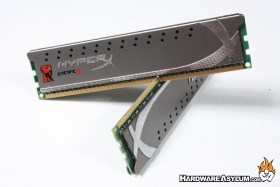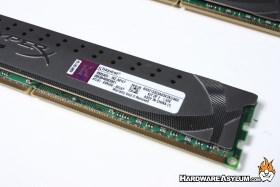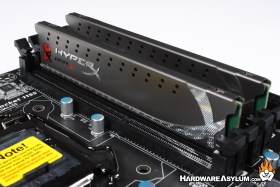Kingston HyperX Dual Channel 2133Mhz CL9 Memory Review
Author: Dennis Garcia
Published: Friday, July 15, 2011
Introduction
When you set out looking at memory modules the process can sometimes be a little overwhelming given the multitude of different vendors seemingly offering the same product. In most cases this can be a real problem but every once in awhile you find a special configuration that matches what you are looking for and might even be at the right price.
In this review we will be looking at a slightly different high performance DDR3 memory kit from Kingston called the HyperX KHX2133C9AD3X2K2/4GX. The name may be long but rest assured this is a 2133Mhz DDR3 memory kit with a CAS rating of 9 designed for the Sandy Bridge platform.
In this review we will be looking at a slightly different high performance DDR3 memory kit from Kingston called the HyperX KHX2133C9AD3X2K2/4GX. The name may be long but rest assured this is a 2133Mhz DDR3 memory kit with a CAS rating of 9 designed for the Sandy Bridge platform.
HyperX is a very familiar name when it comes to performance memory and has, thus far, encompassed all of the major memory types.
Sandy Specific Memory
The Sandy Bridge architecture puts a huge emphasis on memory performance so much in fact that the memory multiplier is actually an integral part of the system and requires some special attention. There are 5 memory multipliers available with Sandy Bridge, 10.67, 13.33, 16, 18.67 and 21.33. These numbers multiplied by the Base clock (BCLK) determine the memory frequency. By default our 2600K boots at 13.33 x 100 giving us a memory frequency of 1333Mhz. If you are fortunate enough to buy higher speed memory you have two options to increase performance.
As we mentioned before our HyperX modules are 2133Mhz parts and come with two fully supported XMP profiles. The high performance XMP that will run the modules at 2133Mhz while the second XMP runs slightly slower at a respectable 1866Mhz. Each are fully configurable but appear to run best with all of the timings set to Auto. Standard voltages apply and when running in XMP mode the voltage is set to 1.65v.
- Set the XMP Profile which will auto adjust for timing, frequency and voltage.
- Manually adjust the settings to match or tweak as you would like.
As we mentioned before our HyperX modules are 2133Mhz parts and come with two fully supported XMP profiles. The high performance XMP that will run the modules at 2133Mhz while the second XMP runs slightly slower at a respectable 1866Mhz. Each are fully configurable but appear to run best with all of the timings set to Auto. Standard voltages apply and when running in XMP mode the voltage is set to 1.65v.
The heatspreader on these HyperX modules is quite small when compared to the GSkill or Patriot modules we have reviewed and should have no problems fitting under even the largest of heatsinks. The overall design is very simple with the majority of the module being flat with sections of embossing that show of the Kingston and HyperX logos.
Frequency and voltage play a huge part in overall heat production and while heat is typically not an issue with DDR3 memory we did discover that these modules run a little warmer than some of the others we have reviewed. The temperature is still well within tolerances but is something to note when it comes to planning your airflow paths.
Frequency and voltage play a huge part in overall heat production and while heat is typically not an issue with DDR3 memory we did discover that these modules run a little warmer than some of the others we have reviewed. The temperature is still well within tolerances but is something to note when it comes to planning your airflow paths.





